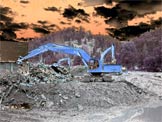|
 |
SERVICES
| Asbestos
and Lead |
 |
Abatement
Monitoring |
 |
Surveys |
| Other
Industrial Hygiene Services |
 |
Indoor
Air Quality Assessments |
 |
Hazardous
Materials Inspections |
 |
Drinking
Water Sampling |
SUMMARY
Global
has a Blanket Purchase Order Agreement with Bureau of Engraving and
Printing to provide a variety of industrial hygiene services.
Under
this contract, Global has conducted asbestos and lead surveys and
abatement monitoring, indoor air quality studies, hazardous materials
inspections, and other industrial hygiene consultation, surveys,
sampling, analysis, and assessments. Furthermore, tasks have involved
bulk sample collection, drinking water sampling for total metals and
total coliform and the handling of potentially hazardous conditions
endemic to the diversified nature of the Bureau of Engraving and
Printing including inks, dyes, ergonomics, noise, radiation, etc.
Global
has the responsibility of monitoring for chemical, physical, water and
biological health hazards. Each of the hazards are discussed in detail
below:
 |
Chemical hazards include dust (silica, asbestos, sawdust, nuisance
dusts, fibrous glass, metal dusts, etc.), asbestos and lead, metal
fumes (cadmium, copper, lead, chromium, zinc, iron, nickel, etc.),
mists (acid, oil, paint, etc.), solvents and vapors including
aliphatic hydrocarbons (gasoline, mineral spirits, turpentine),
alcohols, ketones (acetone, methyl ethyl ketone, methyl isobutyl
ketone), etc., and gases (carbon monoxide, carbon dioxide,
ammonia, hydrogen cyanide, ozone, formaldehyde, etc.). |
 |
Physical
Hazards include noise, vibration, extremes of temperatures,
illumination, ergonomic conditions, indoor air quality
(ventilation, air distribution, air exchange rates, percent
outside air, etc.), ionizing radiation (X ray radiation), and non
ionizing radiation (UV, IR, microwave, radiation, and lasers).
|
 |
Water
contaminants include a wide range of inorganic and organic
compounds. |
 |
Biological
health hazards include bacteria, fungi and algae, pollens,
protozoa, insects, vertebrate derived material, avian excretory
sources, mammalian excretory sources, an animal dander. |
Approximately
35 tasks are conducted each year under this contract.
|


